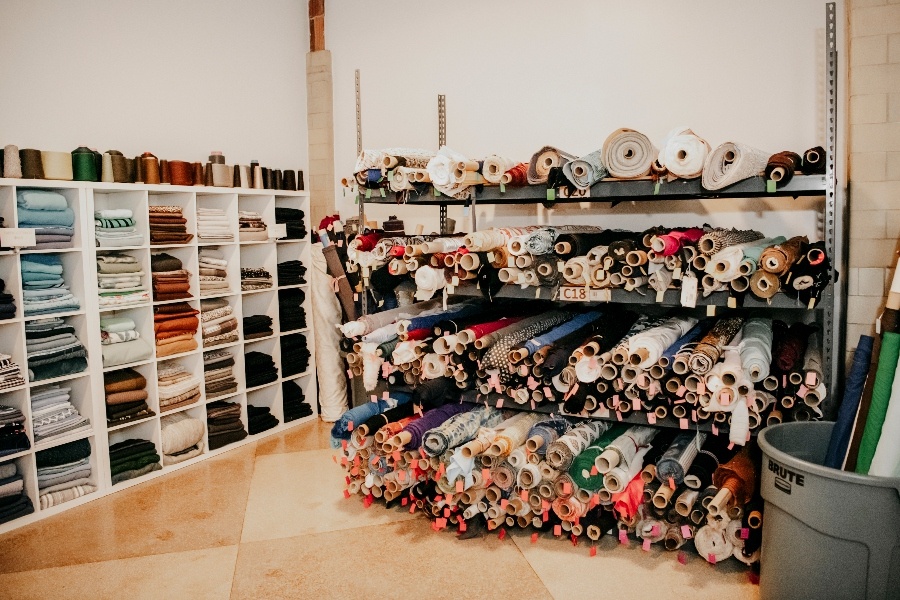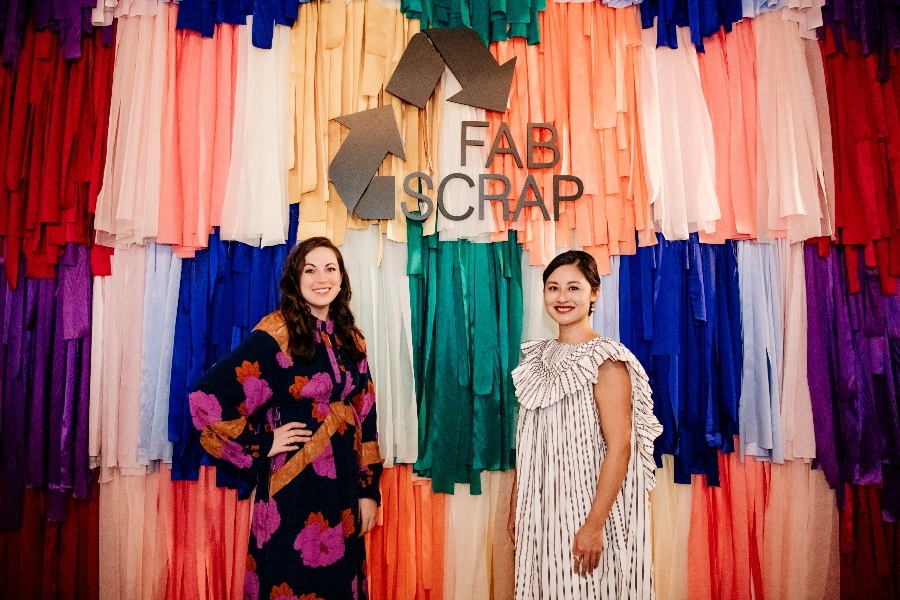This NYC Nonprofit Focused on Reducing Textile Waste Just Expanded to Philly
FABSCRAP — the NYC-founded brand recycling and reusing fashion material headed for landfills — officially opened its second warehouse location inside Bok.

On Monday, FABSCRAP expanded to Philly with a location inside Bok. / Photograph by Chris Siracusa
Every year, millions of tons of textiles are wasted during the fashion industry’s design and production processes. Typically, that excess, unused material ends up in landfills, releasing greenhouse gases and polluting soil and nearby water with dyes and finishing products. (The most recent data shows that 11.3 million tons of textiles ended up in landfills in 2018.)
To help curb negative environmental impact and redistribute reusable material, FABSCRAP — a textile sustainability nonprofit founded in New York City in 2016 — has been reclaiming fabric waste from over 500 brand names, including Oscar de la Renta, J.Crew and URBN, then recycling or selling it for reuse. And this past Monday, they expanded operations by opening their second warehouse location in Philly, right inside the Bok Building.
We chatted with co-founders Jessica Schreiber and Camille Tagle about how FABSCRAP works, plus what opening in Philly means for local designers, consumers and the environment.
How did the two of you become interested in reducing textile waste?
Schreiber: I went to Columbia University for graduate school and studied climate science and policy. While there, I interned at the Bureau of Recycling and Sustainability at the NYC Department of Sanitation, as I was really interested in recycling, waste, and resource use. At the time, New York City had just launched its textile recycling program, Refashion NYC. After my internship, I was hired to manage and grow that e-waste program.
Toward the start of my five-year tenure there, big-name fashion brands began reaching out to me and asking what they should do with their textile waste from the design process. I found there was no place to send them. The city was partnering with GoodWill and Salvation Army, but you don’t really go to those organizations for a roll of silk or a bolt of wool. About 30 brands reached out, so I realized this was an industry problem. I launched a working group in which those brands shared info about their waste — how much they were creating, how often, and what kind — and that basically became a focus group for FABSCRAP. In 2016, I pitched the idea on Project Runway: Fashion Startup, and that’s how we got our first official donations to launch.
Tagle: After going to UCLA for undergrad, I studied design at the Fashion Institute of Technology, then began working in the fashion industry — specifically, eveningwear for luxury design houses. But I saw how much waste was accumulating from each collection season after season. It made me wonder where all of the excess and discarded fabric was going. The single-use operation just kind of got to me, especially because so much of the fabric that goes to waste is reusable. (At FABSCRAP, nearly 60 percent of what we receive is reusable.) All of this made me pause and ask myself what I wanted my contribution to this industry and to our world to be: Add to landfills, or pivot and be part of a sustainable solution?

FABSCRAP co-founders Jessica Schreiber (left) and Camille Tagle (right). / Photograph by Chris Siracusa
What was FABSCRAP like in its early stages?
Schreiber: FABSCRAP was given nonprofit status in September 2016, and a few months later, found space in Jamaica/Queens in part of a warehouse used by underwear-manufacturing company Hanky Panky. They were so supportive of us, and we like to think of that space as a kind of mini incubator for the business. That’s also around the time we first had volunteers come in to help sort through material.
The two of us met kind of serendipitously at the end of 2017 and began hosting a few pop-up fabric sales together. Camille [Tagle] came on full-time as co-founder in January of 2018, which grew our ability to redistribute fabric and set up our first reuse store — which is basically our fabric thrift store — move out of Hanky Panky’s space and into the Brooklyn Army Terminal (which is still our New York City space), and eventually open our second retail location across from FIT.
How did you find your way to Philly?
Schreiber: In January of 2020, we were spending a lot of time out in L.A. We were aiming for a West Coast location, but then COVID happened and our plans went awry. But toward the end of last year, we started having deeper conversations with URBN, who had been shipping us materials from Philly to New York the past few years. Those conversations are really what led us to deciding on Philly as our second location, and Bok is such a hub for creators. URBN gave us a grant to secure our Bok spot and will provide general operating funds during our first two years here.
Tagle: We also have strong relationships with fashion schools in the area, specifically Drexel, Moore and Thomas Jefferson. For the past few years, we’ve partnered with Drexel’s fashion program, as it integrates sustainability courses and is really focused on modernizing design techniques. So for the senior and graduate collections, we determine the fabrics that’ll be given to those students, then students must create a garment made from zero-waste patterning — meaning that all the fabric must be used for the design. These constraints force students to not only think outside the box, but also exercise their creative talents from a more sustainable approach.
How does the FABSCRAP process work?
Schreiber: When there’s a company needing help with their textile waste, they’ll contact FABSCRAP via email or our online form, and we’ll follow-up with a service agreement. Even though we’re a nonprofit, having that fee is important because this isn’t public waste, so it holds the industry itself more accountable. It brings the waste into the brand’s bottom line.
We then provide the company with FABSCRAP bags, in which they put all their excess materials — leather, buttons, zippers, trims, full rolls of material and the like. They submit a pick-up form online. We’re there within five business days and bring everything back to our warehouse to weigh and sort.

FABSCRAP’s sorting stations. / Photograph by Chris Siracusa
Why do you weigh the material?
Schreiber: This is part of our commitment to sustainability. Every brand gets an environmental impact report that lets them know what their total diversion was as well as their CO2 savings. (Ed. Note: In 2020 alone, FABSCRAP helped save nearly 1,300 tons of CO2 — an equivalent of 19,352 trees planted.)
Okay, then you have to go through alllll the received material.
Tagle: We sort everything with volunteer help. Currently, we run volunteer sessions twice per day, five times per week. At our Bok location, we’re able to host 16 to 20 volunteers at a time. They’re sorting for recycling — small pieces that we can’t reuse and end up becoming insulation, mattress stuffing or carpet padding — and reuse, which gets moved to our retail shop. Since launching, we’ve had over 7,000 people volunteer with us, but we have an ongoing call for volunteers!
Can you talk more about your fabric thrift shop? Who is allowed to buy from it, and how much does material cost?
Tagle: Our retail shop is open to anyone who needs material for creative projects. Our customers run the creative gambit: fashion students, home sewers, interior designers, costume designers, puppet and stuffed-animal-makers, and Etsy sellers who are doing cross-stitching and embroidery.
We have a ton of different materials for sale: scraps of fabric, material on rolls that can be cut by the yard, cuttings passed between textile mills and designers for approval during the design process, belts, leather hides, buckles, buttons — really anything. We price by weight, by yard, or sometimes by piece. For example, something cut off a roll could range from $5 to $18 depending on yardage, while other things like buttons are priced by weight at $5 per pound. We also have a pay-what-you-wish per-yard option for a selection of rolls.

FABSCRAP’s fabric “thrift” shop. / Photograph by Chris Siracusa
What do you anticipate your impact on Philly being?
Schreiber: We’re looking forward to building more relationships with the Philly community, and getting to know and collaborating with more local creators and artists. We’re already in conversation with Philly Fashion Week, and will continue working with local schools to support their programs. In January, we’ll launch our Featured Artist/Featured Designer program in Philly, which is a three-month residency where we highlight a local maker who is upcycling or using FABSCRAP fabric in their work. Their designs will be available for sale in our warehouse and online. Our first featured Philly designer is Grant BLVD.
What about FABSCRAP as a whole? How do you see it evolving?
Schreiber: We spend a lot of team time on education and outreach — guest speaking, digital workshops, skill-sharing events for local makers — to raise awareness that textile waste isn’t just what people use and discard, it’s also created by businesses, meaning companies have a responsibility to help reduce the amount of waste. That’s why, in the future, we’d like to have our brand partners bring their mills to the table so we can re-evaluate how fabrics are sampled and shared during the design process.
Tagle: The best way to keep this material out of landfills and combat climate change (which is really our overarching goal) is to get everyone on board in redistributing and continuing the life of the material — and a large part of that comes from holding brands accountable in ways that truly make an impact.


